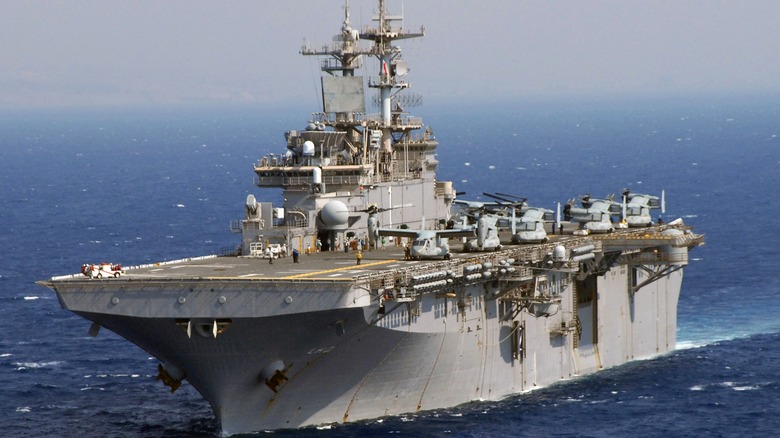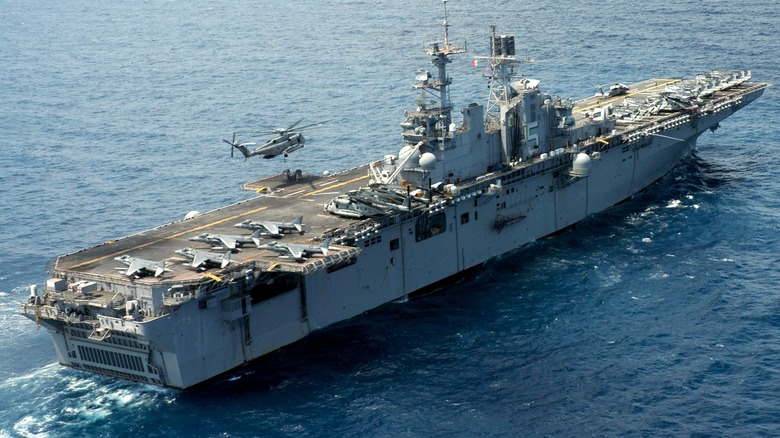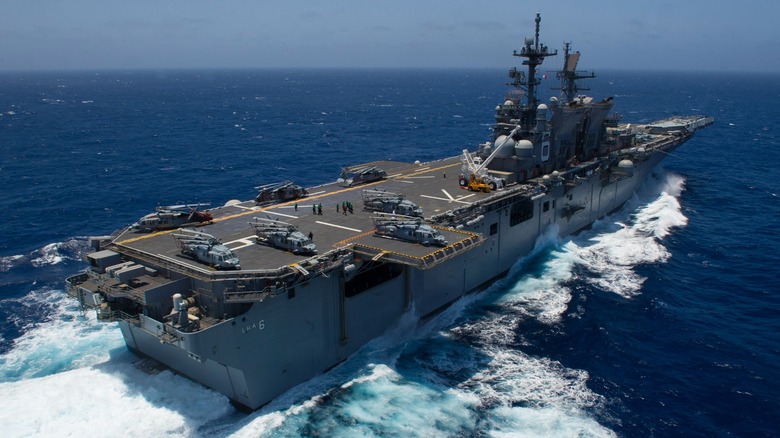9 Mini US Navy Aircraft Carriers (And What They're Used For)
When it comes to aircraft carriers, the United States Navy is king with 11 active carriers as of 2025. More are being built as the aging fleet is being retired to make way for the new Gerald R. Ford-class carriers. These are the largest warships ever constructed, and they make it possible for the U.S. to project power anywhere in the world at any time. While the big carriers get all the press, they're hardly the only ones in operation, as the U.S. Navy has a total of nine smaller aircraft carriers in use.
These are the vessels most people outside of the Navy rarely hear about, as they're often overshadowed by their much larger cousins. Still, the U.S. fleet of mini aircraft carriers is vital to fleet operations and how they support coastal incursions and ground combat missions. These are commonly known as helicopter carriers, which are different from aircraft carriers. Still, they carry plenty of aircraft, and with the advent of vertical/short takeoff and landing (V/STOL) used by the AV-8BHarrier II and the F-35B Lightning II, they can carry more than choppers.
These mini carriers are also capable of launching and recovering a variety of uncrewed aerial vehicles (UAV), so they're incredibly diverse. They're also not mini by any measure, but compared to a ship like the USS Gerald R. Ford (CVN-78), they are comparatively small. The U.S. operates the largest fleet of both aircraft carriers and helicopter carriers, both of which help the U.S. Navy reign supreme across the world's oceans. There are multiple types, and plenty more are planned for the future.
Wasp-class Amphibious Assault Ships
While the world refers to them as helicopter carriers, vessels like the USS Wasp (LHD-1) are actually known as amphibious assault ships, which differ from aircraft carriers in how they support sea-borne operations. The U.S. has operated small carriers like the USS Wasp for decades, and she is the first of her class, having been commissioned in mid-1989. Wasp-class amphibious assault ships displace up to 43,745 tons of seawater when fully loaded and can reach up to 23+ mph.
They measure 844 feet in length, which isn't small, though it is 248 feet shorter than Ford-class carriers. It takes 994 enlisted sailors and 65 officers to operate, though the vessels can support an additional 1,687+ Marines for amphibious assaults and other combat operations. In terms of aircraft, Wasp-class ships can carry a variety, including the AH-1W Super Cobra, the CH-53E Super Stallion, the UH-1Y Venom, the SH-60 Seahawk, and the aforementioned F-35B (Naval variant) and MV-22B Osprey.
They also carry several landing and attack craft to move Marines onto the shore. Since the introduction of the USS Wasp, a total of eight Wasp-class ships have been built: the USS Essex (LHD-2), USS Kearsarge (LHD-3), USS Boxer (LHD-4), USS Bataan (LHD-5), USS Iwo Jima (LHD-7), USS Makin Island (LHD-8), and USS Bonhomme Richard (LHD-6). The latter suffered a devastating fire in 2020. The U.S. Navy opted to decommission the warship instead of repairing it, as the damage was extensive. That leaves seven Wasp-class amphibious assault ships active in the inventory.
America-class Amphibious Assault Ships
In 2014, the U.S. Navy commissioned the first in her class, the USS America (LHA-6), which boasts several innovations and improvements over the older Wasp and the now-retired Tarawa-class amphibious assault ships. Thus far, only two America-class vessels have been commissioned: the aforementioned and the USS Tripoli (LHA-7). A total of 11 are planned, though it takes around eight years to produce just one, so it will be some time before new America-class vessels are welcomed into the Navy's inventory.
America-class vessels were designed based on the USS Makin Island, although several modifications were made to accommodate an increase in aviation support. Unlike the Wasp-class ships, America-class amphibious assault ships were built with the MV-22 and F-35B in mind. As such, they can carry both as well as the same helicopters and support aircraft of Wasp and Tarawa-class vessels. In terms of size, the America-class ships are also 844 feet long, though they displace a bit more seawater, clocking in at 50,368 tons.
The new ships accommodate a crew of 1,059 enlisted sailors and 65 officers, as well as 1,687 Marines. While previous classes of amphibious assault ships were powered by steam boilers, the America-class vessels are powered by a hybrid-electric system that utilizes both an electric generator and a diesel generator, combined with a gas turbine engine. Future versions of the America-class will reduce the size of the aircraft hangars, leaving more room for amphibious warfare well decks, as seen in the design of the USS Bougainville (LHA-8).
What the future holds for America's mini aircraft carriers
The U.S. Navy and Marine Corps are interested in keeping amphibious assault carriers in the active fleet, and they're used often. The USS Wasp participated in both Operations Enduring Freedom (Afghanistan) and Iraqi Freedom. They've also been used for recovery operations following hurricanes, and because they're outfitted to put troops on shore as quickly as possible, the vessels already have the necessary infrastructure and carrying capabilities to do the opposite with civilians from disaster zones.
Capt. Chris Mercer, Amphibious Warfare program manager, said in 2013, "Eleven ships is our stated requirement for large-deck Amphibious Assault Ships. About every four or five years, we are procuring a large-deck amphib. Eventually, all of the America-class ships will replace all of the Wasp-class ships and all of the Tarawa-class ships" (via Defense Tech). Eventually, all amphibious assault ships will be of the America-class, so while some will come online and others will be decommissioned, the Navy should ideally maintain 11 active ships alongside its 11 aircraft carriers, totaling 22.
That puts the U.S. far above the other nations that operate carriers of any kind. Iran recently debuted its first aircraft carrier designed primarily for drone operations, so the future holds a lot of opportunities for similar ships. As of July 2025, the numbers are different, as many ships are under construction. Still, the U.S. maintains an active fleet of 11 aircraft carriers and nine smaller carriers of various classes for a grand total of 20 active flat tops in the U.S. Navy's inventory.



